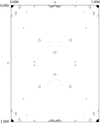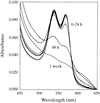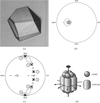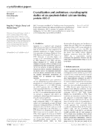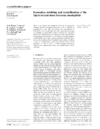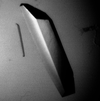issue contents
August 2001 issue

Cover illustration: The glycohydrolase inhibitor cellobiono-imidazole binding to cellobiohydrolase Cel6A. The image was created using the Molray interface between O and POV-Ray. (p. 1201).
topical reviews
Atomic force microscopy (AFM) can be used to investigate macromolecular crystal growth in situ, and to deduce mechanistic, kinetic and phenomenological properties of the process.
research papers
The first observation of the unique environment for thyroxine (T4) binding in tetrameric rat transthyretin (rTTR) is reported as determined by X-ray diffraction.
PDB reference: rat transthyretin complex with thyroxine, 1ie4
The structure of leech anti-platelet protein was solved by single isomorphous replacement and refined to 2.2 Å resolution. It resembles the N-domain of hepatocyte growth factor, but no detectable sequence homology exists. A 36-residue N-terminal region rich in glycine and acidic residues is not visible in the electron-density map.
PDB reference: leech anti-platelet protein, 1i8n
The structure of H. influenzae HslU has been solved to 2.3 Å resolution in crystals which have one-dimensional disorder twinning. A method for computationally correcting for the twinning is described.
Owing to phase changes as a result of freezing, the c axis of T3R hexameric insulin is doubled and the asymmetric unit contains two independent TRf dimers.
hexameric insulin is doubled and the asymmetric unit contains two independent TRf dimers.
The crystal structure of the δ-endotoxin Cry3Bb1 has been refined using data collected to 2.4 Å resolution, with a residual R factor of 17.5% and an Rfree of 25.3%. The structure is made up of three domains: I, a seven-helix bundle (residues 64–294); II, a three-sheet domain (residues 295–502); and III, a β-sandwich domain (residues 503–652).
PDB reference: δ-endotoxin Cry3Bb1, 1ji6
Structure of nitrite reductase at high pH provides a structural explanation for the greatly reduced activity of the enzyme at high pH.
Counter-diffusion was used to produce very high quality crystals of tetragonal lysozyme. Their analysis at atomic resolution (0.94 Å) leads to a detailed description of alternate conformations and of ion binding.
PDB reference: tetragonal lysozyme, 1iee
COMO is a new program for structure determination by the combined molecular-replacement protocol.
crystallization papers
Jararhagin, a metalloprotease/disintegrin-like protein from the venom of B. jararaca, was crystallized and a molecular-replacement solution was obtained using a homology-built model based on the crystal structure of a haemorrhagic zinc metalloproteinase. Refinement techniques are currently being employed in attempts to locate the disintegrin-like domain of the structure.
The 6-phospho-3-hexulose isomerase, YckF, from B. subtilis, was expressed in E. coli, purified to homogeneity and crystallized. Crystals of YckF were shown to diffract beyond 1.7 Å and belong to either space group P6522 or P6122, with unit-cell parameters a = b = 72.4, c = 241.2 Å, and have two molecules in the asymmetric unit.
The catalytic module of pectate lyase 10A, Pel10Acm, from P. cellulosa, was expressed in E. coli, purified to homogeneity and crystallized. Crystals of Pel10Acm were shown to diffract beyond 1.5 Å and belong to space group P21, with unit-cell parameters a = 47.7, b = 106.1, c = 55.4 Å, β = 92.0°, and have two molecules in the asymmetric unit.
The first crystallization of a vertebrate haemoglobin in the haemichrome state is presented.
Orthorhombic crystals of dUTPase from S. cerevisiae have been obtained. Native data have been collected to 2.7 Å using synchrotron X-rays.
A mutant form of T. thermophilus ribosomal protein L22 responsible for erythromycin resistance has been crystallized and X-ray diffraction data have been collected to 1.8 Å resolution.
Crystals of the stimulatory and inhibitory complexes of GTP cyclohydrolase I and its feedback regulatory protein GFRP were obtained. It was shown that each complex consists of two GTPCHI pentamer rings and two GFRP pentamer rings with pseudo-52 point-group symmetry.
The catalase–peroxidase from the halophilic archaeon H. marismortui was purified and successfully crystallized. The crystal diffracts beyond 2.0 Å resolution and belongs to the space group C2.
Gluconate kinase from E. coli has been expressed, purified, and crystallized in three different crystal forms. The crystals diffract to 2.0 Å resolution using synchrotron radiation.
ALG-2 is an apoptosis-linked Ca2+-binding protein required for T-cell receptor-induced, Fas-induced and glucocorticoid-induced cell death. Ca2+-free ALG-2 was crystallized in two crystal forms by the hanging-drop vapour-diffusion method.
A method for the expression, refolding, purification and crystallization of the OpcA invasin from the bacterial pathogen N. meningitidis is described. Diffraction data sets have been collected to 2.0 Å resolution.
A complex of the small GTPase ARL2-GTP and a putative effector protein, the δ subunit of the human cGMP phosphodiesterase (hPDE δ), was successfully crystallized after co-expression of both proteins in E. coli and subsequent copurification. While a first crystal form grew within days and diffracted to 2.3 Å, a second form recrystallized afer several months and diffracted to 1.8 Å.
Crystals of endopolygalacturonase I from S. purpureum have been obtained by vapour-diffusion method. The crystals diffract to ultrahigh (0.96 Å) resolution using synchrotron radiation and belong to space group P1, with unit-cell parameters a = 37.26, b = 46.34, c = 52.05 Å, α = 67.17, β = 72.44 and γ = 68.90°.
Human calcium-binding protein MRP14 was crystallized and preliminary X-ray diffraction studies were performed.
The second and archaebacterial-type aspartyl-tRNA synthetase from the eubacterium T. thermophilus has been crystallized at pH 9.5 in space group P212121. Data were collected to 2.5 Å and molecular replacement gave solutions for the rotation and translation functions.
Prostate kallikrein isolated from horse seminal plasma has been crystallized by the vapour-diffusion method using polyethylene glycol in the crystallization solution. Data collection under cryogenic conditions allowed the determination of the space group (C2) and the unit-cell parameters (a = 72.6, b = 79.1, c = 45.7 Å, β = 98.3°).
In order to obtain the structure of an enzyme from clade I of the haem-containing catalases, two bacterial catalases, CatF from P. syringae and Kat from L. seeligeri, have been crystallized by the hanging-drop vapour-diffusion technique, using PEG and ammonium sulfate as precipitants, respectively.
The N-utilizing substance A (NusA) from M. tuberculosis has been crystallized. Diffraction data for the native protein to 1.7 Å resolution have been collected.
A bacterial enzyme involved in the non-mevalonate pathway of isoprenoid biosynthesis has been cloned, purified and crystallized.
Fab fragments of a family of related mouse esterolytic monoclonal antibodies differing in their catalytic power have been crystallized alone and in complex with a transition-state analogue in forms suitable for high-resolution structure determination.
short communications
The crystal structure of human muscle creatine kinase has been determined by molecular replacement at 3.5 Å resolution. Both strict and approximate twofold symmetry dimers exist in the crystal.
PDB reference: human muscle creatine kinase, 1i0e
This public web service allows quick and easy production of publication-quality images from the molecular-modelling program O.
A statistically significant and unbiased test on insulin crystals shows that crystals grown in microgravity are superior to those grown in unit gravity.


 journal menu
journal menu




















